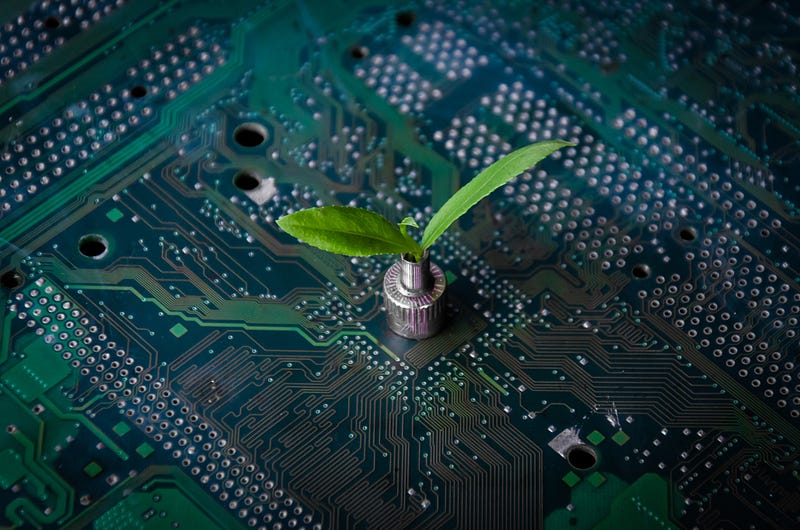AI saves the day — and the planet
By Apurva Jain, Data Science and Business Administration, 2023

If people are excited about how the movement against plastic straws is saving the sea turtles, artificial intelligence — and its rising significance in saving the planet — will blow them away. Artificial intelligence (AI) is the endeavor to simulate human intelligence in computer systems, encompassing the notable subfields of machine learning and robotics. With its rapidly expanding role in healthcare, the environment, business, and everyday life, AI is the future of technology. In recent years, valuable research has revealed artificial intelligence to be a broadly influential tool in tackling climate change. As arguably the greatest crisis facing the world today, climate change necessitates a monumental solution, and AI seems to be just that.
The strategy against climate change can ultimately be summarized by two key approaches. Climate adaptation — the method of “managing the unavoidable” — involves establishing resilience, managing natural disasters, and reducing vulnerability to the harmful consequences of climate change. Conversely, with climate mitigation, experts aim to “avoid the unmanageable” by reducing global emissions of greenhouse gases through various means. Both strategies are advanced rapidly by the ascent of AI.
Widely dubbed the “new electricity,” AI has the ability to innovate virtually any major industry.
Widely dubbed the “new electricity,” AI has the ability to innovate virtually any major industry. Coincidentally, electricity systems are one of the most widespread, significant industries to benefit from all that AI has to offer. Today, these systems account for 25 percent of the planet’s anthropogenic greenhouse gas emissions annually. Even renewable energy generators like solar panels and wind turbines produce excessive amounts of carbon dioxide because of the buffers that coal and natural gas plants provide. Although these safeguards are necessary for when sunlight or wind power is low, carbon-free solutions are possible. AI can enhance the necessary technologies to forecast and establish advanced electricity markets, and, in the meantime, help reduce pollution from current generators. Beyond that, by combining existing heuristics with physics and experimental data, machine learning can expedite materials science to design equipment that best harnesses energy from variable resources.
Solar geoengineering also offers the capacity to moderate some of the most hazardous results of climate change — largely by increasing Earth’s reflectivity. However, its potential side effects make this solution a risky one to employ, and that’s where AI comes into play. From years of observations following volcanic eruptions, researchers have extensive data of how injecting sulfate aerosols into the stratosphere can offset the increasing warming effect of carbon dioxide. But with these assets come the dangers of sulfate to both agriculture and human health. Machine learning can not only manage this computational load of information, but also optimize the material and chemical properties of aerosols to overcome these risks. On top of that, algorithms like the Gaussian process can establish best-fit parameters for aerosols by imitating climate model outputs with only 350 runs rather than over 100,000. This allows experts to determine the optimal levels of sulfate aerosols in the stratosphere for only a fraction of the cost and time.
Artificial intelligence is not the supreme answer to the vast catastrophe that is climate change. Instead, its solution lies precisely where the problem started — with people.
Regardless of how revolutionary AI is and will continue to be, the field presents many challenges. The sheer unavailability of data from private sectors and third-world countries can cause false representations of local, national, and global cases of climate change. The factors and yield of agriculture in India, for instance, are not as easily tracked and reported as crop production in western nations. Moreover, the ethical grounds of AI are still vastly distrusted. Without absolute transparency in machine design and the ability to preeminently overturn automated processes if and when desired, the development of AI can easily crumble.
Above all, the greatest drawback of the adoption of AI is the likelihood of humans placing blind faith in these technologies. Artificial intelligence is not the supreme answer to the vast catastrophe that is climate change. Instead, its solution lies precisely where the problem started — with people. Humanity is undoubtedly the cause of and the most substantial contributor to climate change. AI can mitigate the consequences of mankind’s carelessness, yet true reform begins with every individual.
Weather, Climate, and Society (2019). DOI: 10.1175/wcas-d-18–0134.1
